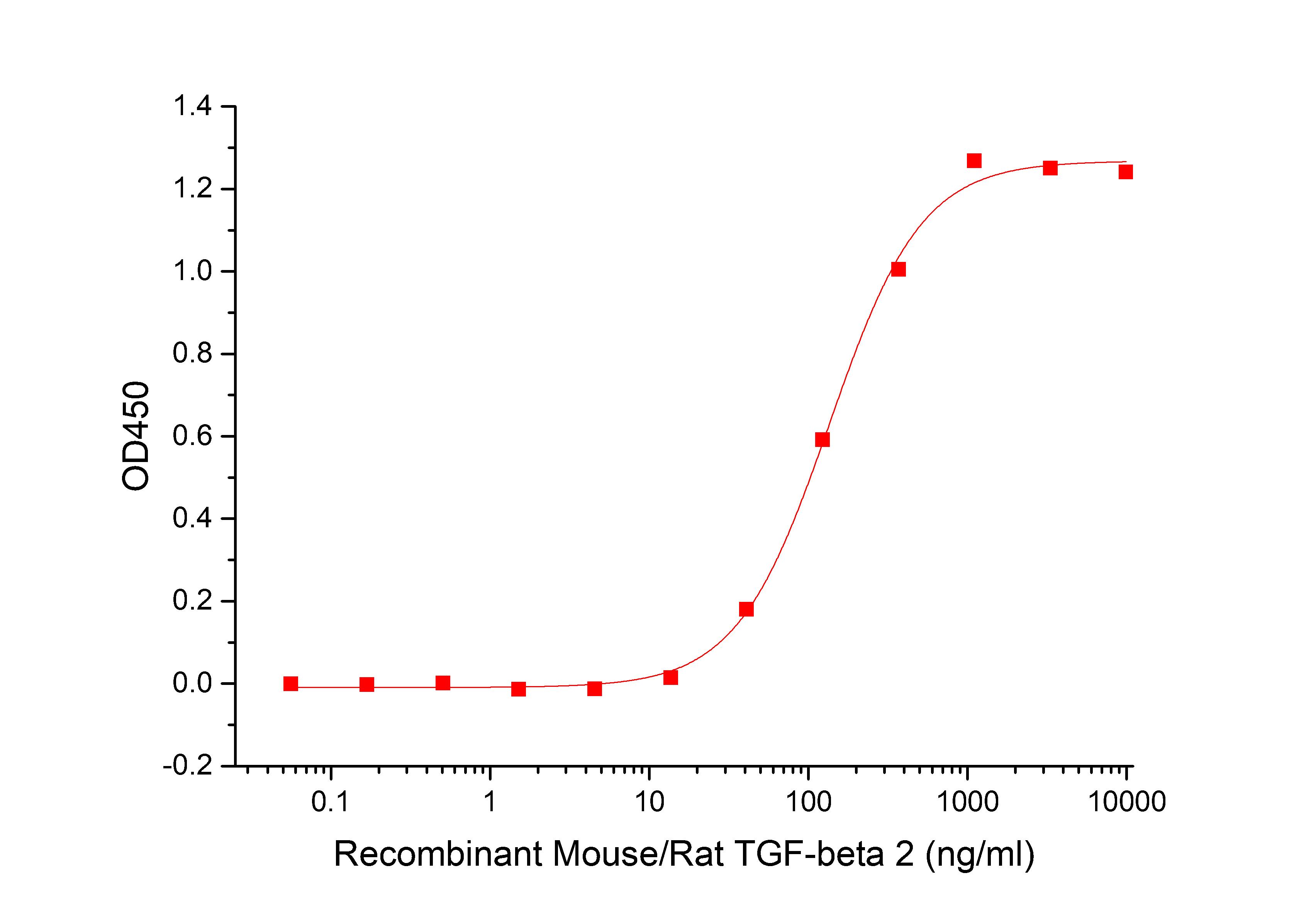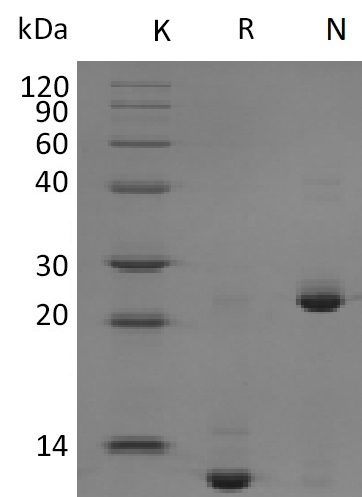 Your shopping cart is currently empty
Your shopping cart is currently empty
TGF beta 2 Protein, Mouse/Rat, Recombinant
Transforming growth factor beta 2 (TGF-β2) is a member of TGF-beta superfamily that shares a characteristic cysteine knot structure. Mice with TGF-β2 gene deletion show defects in development of cardiac, lung, craniofacial, limb, spinal column, eye, inner ear and urogenital systems. All TGF-β isoforms signal via the same heteromeric receptor complex, consisting of a ligand binding TGF-β receptor type II (TβR-II), and a TGF-β receptor type I (TβR-I). Signal transduction from the receptor to the nucleus is mediated via SMADs. TGF-β expression is found in cartilage, bone, teeth, muscle, heart, blood vessels, haematopoitic cells, lung, kidney, gut, liver, eye, ear, skin, and the nervous system.

TGF beta 2 Protein, Mouse/Rat, Recombinant
| Pack Size | Price | USA Warehouse | Global Warehouse | Quantity |
|---|---|---|---|---|
| 5 μg | $74 | 7-10 days | 7-10 days | |
| 10 μg | $118 | In Stock | In Stock | |
| 20 μg | $187 | 7-10 days | 7-10 days | |
| 50 μg | $350 | 7-10 days | 7-10 days | |
| 100 μg | $543 | 7-10 days | 7-10 days | |
| 200 μg | $843 | 7-10 days | 7-10 days | |
| 500 μg | $1,520 | 7-10 days | 7-10 days |
Product Information
| Biological Activity | Immobilized Mouse TGFBR2 -Fc at 10μg/ml (100 μl/well) can bind Mouse/Rat TGF-beta 2*.*: Biotinylated by NHS-biotin prior to testing. The ED50 of Mouse TGFBR2 -Fc is 0.136 ug/ml. (Regularly tested)  |
| Description | Transforming growth factor beta 2 (TGF-β2) is a member of TGF-beta superfamily that shares a characteristic cysteine knot structure. Mice with TGF-β2 gene deletion show defects in development of cardiac, lung, craniofacial, limb, spinal column, eye, inner ear and urogenital systems. All TGF-β isoforms signal via the same heteromeric receptor complex, consisting of a ligand binding TGF-β receptor type II (TβR-II), and a TGF-β receptor type I (TβR-I). Signal transduction from the receptor to the nucleus is mediated via SMADs. TGF-β expression is found in cartilage, bone, teeth, muscle, heart, blood vessels, haematopoitic cells, lung, kidney, gut, liver, eye, ear, skin, and the nervous system. |
| Species | Mouse,Rat |
| Expression System | HEK293 Cells |
| Tag | Tag Free |
| Accession Number | P27090 |
| Synonyms | transforming growth factor β-2,transforming growth factor beta-2,TGF-β-2,TGF-β2,TGF-beta-2,TGF-beta2,TGFB2,Polyergin,MGC116892,G-TSF,Glioblastoma-derived T-cell suppressor factor,Cetermin,BSC-1 cell growth inhibitor |
| Amino Acid | Ala303-Ser414 |
| Construction | Ala303-Ser414 |
| Protein Purity | Greater than 95% as determined by reducing SDS-PAGE. (QC verified)  |
| Molecular Weight | 12 KDa (reducing condition) |
| Endotoxin | < 0.1 ng/µg (1 EU/µg) as determined by LAL test. |
| Formulation | Lyophilized from a solution filtered through a 0.22 μm filter, containing 4 mM HCl. |
| Reconstitution | Reconstitute the lyophilized protein in 4mM HCl. The product concentration should not be less than 100 μg/ml. Before opening, centrifuge the tube to collect powder at the bottom. After adding the reconstitution buffer, avoid vortexing or pipetting for mixing. |
| Stability & Storage | Lyophilized powders can be stably stored for over 12 months, while liquid products can be stored for 6-12 months at -80°C. For reconstituted protein solutions, the solution can be stored at -20°C to -80°C for at least 3 months. Please avoid multiple freeze-thaw cycles and store products in aliquots. |
| Shipping | In general, Lyophilized powders are shipping with blue ice. Solutions are shipping with dry ice. |
| Research Background | Transforming growth factor beta 2 (TGF-β2) is a member of TGF-beta superfamily that shares a characteristic cysteine knot structure. Mice with TGF-β2 gene deletion show defects in development of cardiac, lung, craniofacial, limb, spinal column, eye, inner ear and urogenital systems. All TGF-β isoforms signal via the same heteromeric receptor complex, consisting of a ligand binding TGF-β receptor type II (TβR-II), and a TGF-β receptor type I (TβR-I). Signal transduction from the receptor to the nucleus is mediated via SMADs. TGF-β expression is found in cartilage, bone, teeth, muscle, heart, blood vessels, haematopoitic cells, lung, kidney, gut, liver, eye, ear, skin, and the nervous system. |
Dose Conversion
Calculator
Tech Support
| Size | Quantity | Unit Price | Amount | Operation |
|---|

Copyright © 2015-2025 TargetMol Chemicals Inc. All Rights Reserved.



